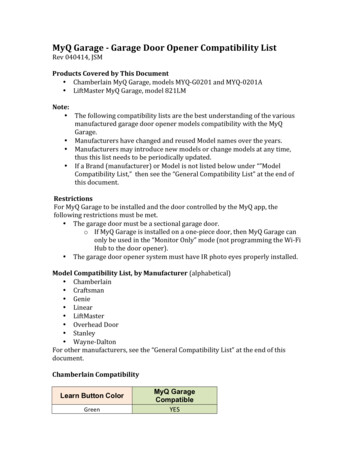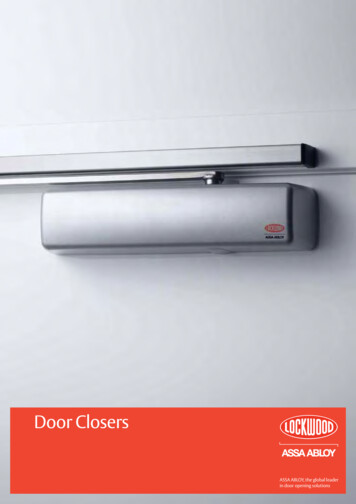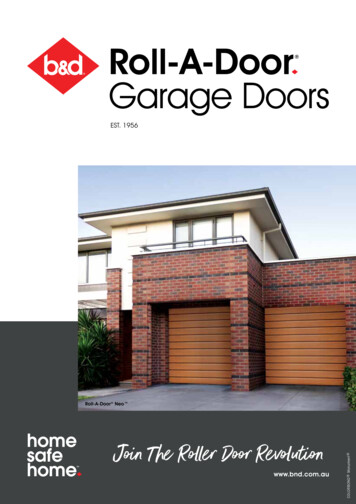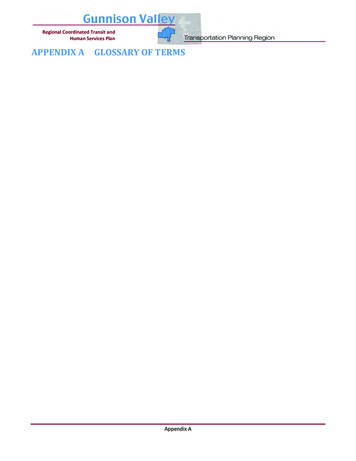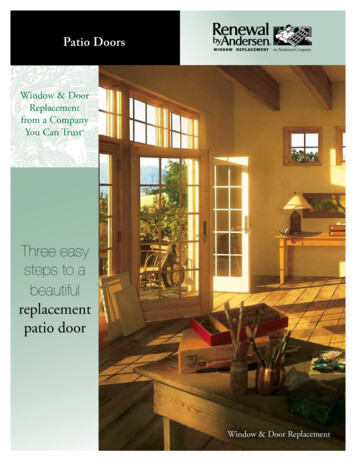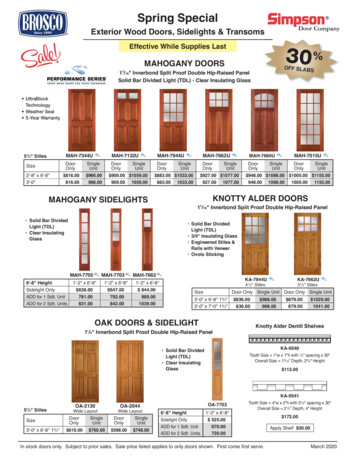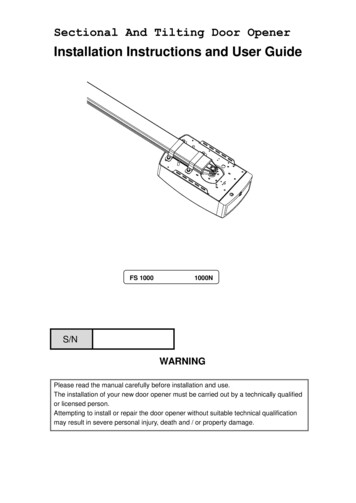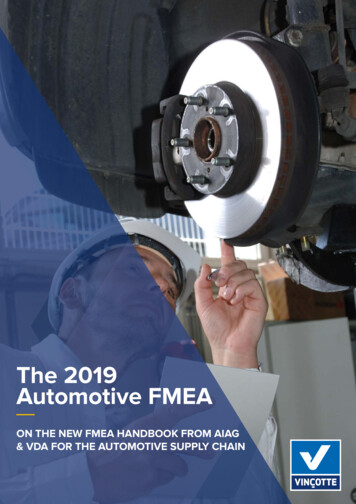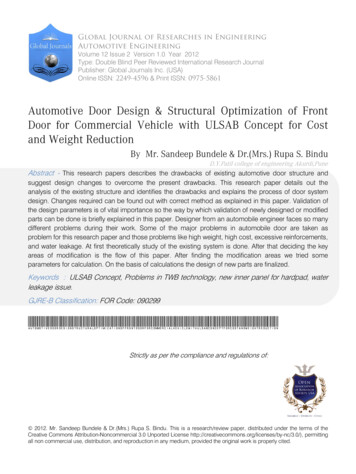
Transcription
Global Journal of Researches in EngineeringAutomotive EngineeringVolume 12 Issue 2 Version 1.0 Year 2012Type: Double Blind Peer Reviewed International Research JournalPublisher: Global Journals Inc. (USA)Online ISSN: 2249-4596 & Print ISSN: 0975-5861Automotive Door Design & Structural Optimization of FrontDoor for Commercial Vehicle with ULSAB Concept for Costand Weight ReductionBy Mr. Sandeep Bundele & Dr.(Mrs.) Rupa S. BinduD.Y.Patil college of engineering Akurdi,PuneAbstract - This research papers describes the drawbacks of existing automotive door structure andsuggest design changes to overcome the present drawbacks. This research paper details out theanalysis of the existing structure and identifies the drawbacks and explains the process of door systemdesign. Changes required can be found out with correct method as explained in this paper. Validation ofthe design parameters is of vital importance so the way by which validation of newly designed or modifiedparts can be done is briefly explained in this paper. Designer from an automobile engineer faces so manydifferent problems during their work. Some of the major problems in automobile door are taken asproblem for this research paper and those problems like high weight, high cost, excessive reinforcements,and water leakage. At first theoretically study of the existing system is done. After that deciding the keyareas of modification is the flow of this paper. After finding the modification areas we tried someparameters for calculation. On the basis of calculations the design of new parts are finalized.Keywords : ULSAB Concept, Problems in TWB technology, new inner panel for hardpad, waterleakage issue.GJRE-B Classification: FOR Code: standWeightReductionStrictly as per the compliance and regulations of: 2012. Mr. Sandeep Bundele & Dr.(Mrs.) Rupa S. Bindu. This is a research/review paper, distributed under the terms of theCreative Commons Attribution-Noncommercial 3.0 Unported License http://creativecommons.org/licenses/by-nc/3.0/), permittingall non commercial use, distribution, and reproduction in any medium, provided the original work is properly cited.
Automotive Door Design & StructuralOptimization of Front Door for CommercialVehicle with ULSAB Concept for Cost andWeight ReductionKeywords : ULSAB Concept, Problems in TWBtechnology, new inner panel for hardpad, water leakageissue.RI.Introductionecently, there have been two approaches inreducing automobile weight. One is by usingmaterial lighter than steel and the other is byredesigningthe steel structure. Although theformer seems very effective, it is very expensive so that itmay only be used for an expensive automobile.Therefore, the automobile industry is trying to use steel,Year 2012Abstract - This research papers describes the drawbacks ofexisting automotive door structure and suggest designchanges to overcome the present drawbacks. This researchpaper details out the analysis of the existing structure andidentifies the drawbacks and explains the process of doorsystem design. Changes required can be found out withcorrect method as explained in this paper. Validation of thedesign parameters is of vital importance so the way by whichvalidation of newly designed or modified parts can be done isbriefly explained in this paper. Designer from an automobileengineer faces so many different problems during their work.Some of the major problems in automobile door are taken asproblem for this research paper and those problems like highweight, high cost, excessive reinforcements, and waterleakage. At first theoretically study of the existing system isdone. After that deciding the key areas of modification is theflow of this paper. After finding the modification areas we triedsome parameters for calculation. On the basis of calculationsthe design of new parts are finalized. Then 3D models areprepared in CATIA V5, which are used for analysis purpose.Finally on the basis of analysis results actual metal parts aredeveloped in the proto shop and fitment trials are taken on thevehicle. Once the fitment trial is completed actual testing isdone on the vehicle. Comparing those results with the oldresults the improvement is suggested, during this study somespecific parameters are chosen for observation andimprovement. On the basis of these results final design isfrizzed.σwhich is not costly and recyclable. Lightweight steel canbe achieved by improving the performance of thestructure or adopting new manufacturing techniques. 25One of the efforts is the ULSAB (ultra light steelautobody) concept. ULSAB suggests three main weightreduction techniques such as hydro-forming and thetailor welded blank (TWB). In this research, the TWBtechnique is utilized for lightweight door design, and adesign process is proposed for optimizing theautomobile TWB door. In the automotive door assembly,door inner panel is divided into different thicknesswithout reinforcement components and differentthickness sheets, plates are assembled by laserwelding. The use of tailored steel solutions eliminatesthe need for additional reinforcements and overlappingjoints in the body, saving material and further reducingtotal weight. In this way, tailored blanks are a significantenabler to meet specified CO2 targets. Reducing theweight of a car, reduces CO2 emissions. Objective ofthis paper is Low cost door design for developingcountries India, Srilanka, South Africa withoutcompromising any performance and regulatoryrequirements for example removing molded trim withhard pad, cost saving approximately 1400 Rs/set.Reducing the weight of door assembly by reducingnumber of components and by using advancetechnologies like tailor welded blank and high strengthmaterial. Existing design has a water leakage problemfrom the assembly of inner door panel and seal becauseof different thickness of inner panel. The parts which arenewly designed or modified are designed on the basisof space constrained. The main constrained is thatavoids as much as modification in the machined parts.Global Journal of Researches in Engineering ( B ) Volume XII Issue II Version IαMr. Sandeep Bundele & Dr.(Mrs.) Rupa S. BinduAuthor α : Student M.E Design, D.Y.Patil college of engineeringAkurdi, Pune. E-mail : Sandeep bundele@yahoo.comAuthor σ : Prof and Head, Department of Mechanical engineering,D.Y. Patil college of engineering Akurdi, Pune.E-mail : rsbindu31@rediffmail.com 2012 Global Journals Inc. (US)
Automotive Door Design & Structural Optimization of Front Door for Commercial Vehicle with ULSABConcept for Cost and Weight ReductionII.Exsisting Inner Door Panel Designa) Material used for exsisting inner door panel0.7mm thick, EDD 513,1.6mm thick, St40eYear 2012Table 1 : For material propertiesGlobal Journal of Researches in Engineering ( B ) Volume XII Issue II Version I26Fig 1 : Front Door Inner Panel, Weight: 6.3 kgInner door panel is a component which is usefor strengthening the door assembly and it is one of themost important components on witch all accessories aremount like hinges, glass guide channel. Front door sill,window winding regulator, hard pad, molded trim, latchetc. Front door inner panel is use for sealing purposewhen the primary sill is mounted on this. The weight ofDoor inner panel is near about 7to8kg depends upon itsmaterial and its thickness. The possible method is theintegration method. In the integration method, the part isstamped out of a single blank. This reduces the numberof tools needed; the assembly cost, and eliminates anyfit ability problem. However, the design engineer isforced to work with same grade, thickness, andcorrosion resistance throughout the entire part. Sincethe most demanding of all these conditions must besatisfied for the entire blank, this would increase the costand weight of the partGrade St 35EGrade St 40E% Carbon% Mangnese%Sulphur30 PPM max0.35-0.450.010 max30 PPM max0.35-0.450.010 max%Phosphorus% Silicon% Alumini0.06 max0.015 max0.02 -0.040.06 max0.015 max0.02 -0.04% Titanium% 5% Boron5-10 PPM5-10 PPMGrade St 35EGrade St 40EYieldStrengthTensileStrength% Elongation180-220 MPa230-270 MPa345 -386 MPa390 MPa min35 min34% minR1.6 -1.91.5 -1.9N0.21 -0.240.20 -0.24III. Design Of New Door Inner Panel ForReducing Cost And Weight Of FrontDoor AssyIn this paper we are going to reduce weight of afront door assembly by using tailor welded blankconcept for front door inner panel and using lessthickness high strength material and reducing cost byreplacing molded trim with hard pad in front doorassembly and saving 1400 Rs/set.a) Methods of preparing inner door panelFig 2 : Assembly of molded trim and with inner panel 2012 Global Journals Inc. (US)1. In current automotive stamping technology, thereare two basic paths that can be followed to arrive atthe final inner door panel. The first method is partdisintegration or part separation. In this technique,each different section of the blank is stampedseparately and then spot welded together in theshape of the final part. This method has numerousadvantages such as the ability to select the specificproperties, i.e. the strength, thickness, corrosionresistance, etc. of each area of the blank. Thismethod also gives a higher yield ratio ofmaterialused.2. The other possible method is the integrationmethod. In the integration method, the part isstamped out of a single blank. This reduces the
b) Design guidelines for designing door inner panel27Fig 3 : Significance of ribs and beadsc) Material used for new door inner panel0.7mm thick, EDD 513, 1.2mm thick, DP590Table 2 : For material propertiesElement% Carbon% Manganese%Sulphur%PYield StrengthTensile Strength% ElongationDP 5900.08-0.121.1-1.60.004 max0.02 max350min MPa590min MPa24 mind) Design of new door inner panel for solving waterleakage issueBeads and ribs increases the cross sectionalarea of component and load taking capacity increases.By adding beads we are able to reduce spring backeffect of component.Tailor Welded Blanks are made from individualsteel sheets of different thickness, strength and coatingwhich are joined together by laser welding. When wedesign inner door panel with tailor welded blank in witchsome portion of a panel having different thickness andother is different. In our case some portion of door innerpanel is 0.7mm thick shown below with pink color andanother is 1.2mm thick shown below with sky color.There is a 0.5mm gap between these two thicknessesand this is the reason that water is leakage betweendoor inner panel and secondary sill in shower test.Below figures gives the idea of existing and newcoditions. 2012 Global Journals Inc. (US)Global Journal of Researches in Engineering ( B ) Volume XII Issue II Version Inumber of tools needed; the assembly cost, andeliminates any fit ability problem. However, thedesign engineer is forced to work with same grade,thickness, and corrosion resistance throughout theentire part. Since the most demanding of all theseconditions must be satisfied for the entire blank, thiswould increase the cost and weight of the partsignificantly.3. A solution to the problems listed above is theutilization of tailor-welded blanks. A tailor-weldedblank is a blank that is comprised of two separatepieces of sheet metal that has been weldedtogether previous to stamping. Tailor welded blanksallow the welding of the different grades, differentthickness or different corrosion coatings together inorder give the properties needed in different areas,without increasing the number of tools needed toform the part and eliminating the fit ability concerns.They also allow a high degree of flexibility indesigning parts and large blanks can be formedfrom much smaller sheets .The use of tailor-weldedblanks would reduce the weight of the car. Havingthe ability to selectively place different thickness ofmaterial would result in weight reductions. Anexample of this used in production is the door innerpanel. The only strength requirement on a doorinner is in the region where the hinges attach to thepanel.Year 2012Automotive Door Design & Structural Optimization of Front Door for Commercial Vehicle with ULSABConcept for Cost and Weight Reduction
Year 2012Automotive Door Design & Structural Optimization of Front Door for Commercial Vehicle with ULSABConcept for Cost and Weight ReductionGlobal Journal of Researches in Engineering ( B ) Volume XII Issue II Version I28Fig 6 : New front door inner panelFig 4 : Existing inner door panel condition with insidethicknessFig 5 : New inner door panel condition with outsidethicknessNew front door inner panel for hardpad & no waterleakage issue,weight-5.9kgFig 7 : Assembly of new door inner panel & hard padIV.Forming AnalysisThe technique of sheet metal forming analysisrequires non-contact optical 3D deformation measuringsystem. The system analyzes, calculates anddocuments deformations of sheet metal parts, forexample. It provides the 3D coordinates of thecomponent's surface as well as the distribution of majorand minor strain on the surface and the materialthickness reduction. In the Forming Limit Diagram, themeasured deformations are compared to the materialcharacteristics. The system supports optimization 2012 Global Journals Inc. (US)
Automotive Door Design & Structural Optimization of Front Door for Commercial Vehicle with ULSABConcept for Cost and Weight ReductionV.Cae AnalysisTable 3 : Boundary and Load conditionsLocationNo2Load CasesTorsionalrigidity top3Torsionalrigidity bottom4Beltline inner5Beltline outerForceAn inboard force 1000N isapplied to the door innercorner(top)An inboard force 1000N isapplied to the door innercorner(bottom)A horizontal force of 600N isappliedtothebeltlinereinforcement at the midpointof the window opening (inner)A horizontal force of 600N isappliedtothebeltlinereinforcement at the midpointof the window opening (outer)a) ResultsStiffness Analysis :Fig 8 : Color bands in forming limit dig1) Predicted vertical stiffness of door with hard padinteriors is lower than existing front door design2) Predicted beltline inner stiffness of door with hardpad interiors is lower than existing front door design3) Predicted beltline outer stiffness of door with hardpad interiors (CAE Proposed design) is equivalentto existing front door designDoor Sag Analysis :Predicted maximum elastic deflection andpermanent set in door under worst door sag load caseare as follows.1) Existing design: Maximum elastic deflection is7.75mm and permanent set is 0.232) Hard pad design: Maximum elastic deflection is9.27mm and permanent set is 0.34VI.Fig 9 : Inner panel in safety zoneConclusionIn this paper we design new front doorassembly components with tailor welded blanktechnology for reducing weight and cost of doorassembly. Tailor-welded blanks allow combiningdifferent strengths of steel in one part without addingcomplications at the joints. Weight of a door assembly is 2012 Global Journals Inc. (US)Year 2012To evaluate the stiffness and sag performanceof the front door for both existing and hard pad. Differentstiffness’s considered for front door assemblies are. Theobjective of this analysis is to predict the vertical sagbehavior of the front door assembly of CUB (GoodsCarrier). As per the procedure, there should not be apermanent set exceeding 1 mm and maximum latchpoint deflection (elastic) should not be more than 10mm. At the latch point under two conditions29Global Journal of Researches in Engineering ( B ) Volume XII Issue II Version Iprocesses in sheet metal forming by means of; Fastdetection of critical deformation areas, Solving complexforming problems. The optical forming analysis withforming analysis system provides for precise and fastmeasurement of small and large components using ahigh scanning density. Forming analysis systemoperates independently of the material. It can analyzecomponents made from flat blanks, tubes or othercomponents manufactured by an internal high pressureforming process (Hydro forming). The Forming limitcurve is used in sheet metal forming for predictingforming behavior of sheet metal. The diagram attemptsto provide a graphical description of material failuretests, In order to determine whether a given region hasfailed, a mechanical test is performed. The mechanicaltest is performed by placing a circular mark on the workpiece prior to deformation, and then measuring thepost-deformation ellipse that is generated from theaction on this circle.
Automotive Door Design & Structural Optimization of Front Door for Commercial Vehicle with ULSABConcept for Cost and Weight Reductionreducing by 0.4 kg, by reducing weight of a door innerpanel by using less thickness high strength material,reduce cost by replacing molded trim with hard pad. Weare successfully solved water leakage problem bymodeling front door inner panel correctly.Year 2012References Références ReferenciasGlobal Journal of Researches in Engineering ( B ) Volume XII Issue II Version I301. New methods for forming Tailor welded blanks.Date published: 1999-03-01,Paper no: 1999-010681,DOI: 10.427/1999-01-0681, By Brad Kinsey,Jian Cao2. Formability Issues in the Application of TailorWelded Blank Sheets. Date Published: 1993-03-01,Paper Number: 930278 ,DOI: 10.4271/930278, by,Ming F. Shi - National Steel Corp. Ken M. Pickett National Steel Corp. Kumar K. Bhatt - GeneralMotors Corp.3. Describing the formability of tailor welded blanks.Date Published 2002-01- 2085 By Rich Davies andMark Smith4. The Stiffness of Automobile Inner Panels. DatePublished: 1987-11-08,PaperNumber: 871294 DOI:10.4271/871294 by Toshiaki Sakurai - MitsubishiMotors Corp, Hiroyuki Ono - Mitsubishi MotorsCorp.5. E Balmuth, “Steel alloy for thick sectionapplications,” presented at TMS-AIME meeting atDenver, co, February 1993.6. The development of vibration damping steel sheetsfor inner panels of Automotive Vehicles. Paper no:911083,By Toshiaki Shiota, Hiroyuki Nagai.7. Laser Welding of Advanced High Strength Steels forTailor Welded Blank (TWB) Applications. DatePublished: 2009-12-13, Paper Number: jan - ARCI, J.K.Sarin Sundar - ARCI ,G. Padmanabham – ARCI8. Integrated Inner Door Panel/Energy AbsorberDesigns for Side Impact Occupation Protection.Date Published: February 26-29, 1996, PaperNumber: 960151 by Luis Lorenzo, Scott Burr, andKaren Fennessy-Ketola- Dow Chemical Co.9. Door System Design for Improved Closure SoundQuality. Date Published: 1999-05-17,Paper Number:1999-01-1681, DOI: 10.4271/1999-01-1681 by A.Petniunas - Ford Motor Co. N. C. Otto - Ford MotorCo., S.Amman-FordMotorCo.R.Simpson–Ford.10. Development of Lightweight Door Intrusion BeamsUtilizing an Ultra High Strength Steel, DatePublished: 1975-02-01, Paper Number: 750222,DOI: 10.4271/750222, T. E. Fine - Inland Steel Co.S. Dinda - Chrysler Corp. 2012 Global Journals Inc. (US)
prepared in CATIA V5, which are used for analysis purpose. Finally on the basis of analysis results actual metal parts are developed in the proto shop and fitment trials are taken on the vehicle. Once the fitment trial is completed actual testing is done on the vehicle. Comparing those results with the old
